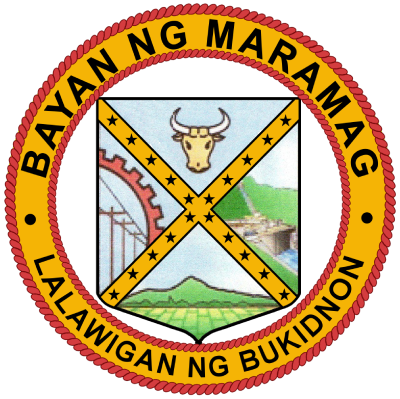Historical Background
Cultural Background
Maramag comes from “Ag Ramag” a contracted Manobo term for “Ag Ramag Ki Dini”, which if freely translated, means “LET US EAT OUR BREAKFAST HERE.” The story goes that the Manobos were constantly in skirmish with the Maranaos for supremacy over the locality. On the bank of the Pulangi River, before going to battle, they would eat their breakfast atop the large flat stones that abound in the area. Each time set for battle, they would stop on the place, draw their plans, and have their meals. The place is really nice as it offers a nearly level area, with the flat stones serving as tables and near the river where one can simply wash their hands before taking in some food. The waters are also enticing where one can bathe and rest before or after the skirmishes. The practice become common that even in times of peace and as a sign of good faith, these “lumads” or natives or early settlers even invite others who happen to pass by to partake meals with them – in much the same was as Maramag was equated to a picnic ground where one can rest and take meals as short respite from either the travel, the trekking, the hunting and trapping or from battle.
Through the years, even Christians (referred to as dumagats) started to come and settle near the place. They too would stop and eat their meals on these big flat stones during their hunting trips or as they travel on foot from one valley to another. As more and more Christian settlers occupied the surrounding places, the place become more commonly called as Maramag – a homonym or a contraction of the original Manobo term – “Ag Ramag”
Maramag was formally created as a municipality through Executive Order No. 272 issued by then President Carlos P. Garcia on July 1, 1956. The Poblacion of Maramag was formerly located in Barangay Base Camp, three (3) kilometers away from the present Poblacion. After the World War II and upon the completion of the Sayre Highway, people started to move along the highway in a linear then nodal fashion and later concentrically forming the Poblacion today, composing Barangay North and South Poblacions.
It is is an inland municipality approximately 142 kilometers southeast of Cagayan de Oro City, around 51 kilometers south of Malaybalay City, the Provincial Capital of Bukidnon and 156 kilometers from Davao City. The municipality is strategic in location since it can be reached through any of the cities mentioned. It is politically subdivided into twenty (20) barangays occupying 52,198.98 hectares land of varied slopes.The largest barangay is kuya and it is characterized by favorable climate and deep soils which contribute to the essential diversity of its biological and physical environment. Around 44.0 percent or 22,967.12 hectares of the total land area of the municipality is classified as Alienable and Disposable Land (A & D) and the remaining 29,231.86 hectares (56.0 %) is classified as Timberland or Forestland as per proclamation.
Maramag belongs to Coronas Type IV climate wherein rainfall is more or less evenly distributed all throughout the year. It serves as one of the contributing factor to the diversity of its biological and physical environment. The average temperature of Maramag during the past ten-year period (CY 1996-2005) was 26.32 ˚C. The coldest month recorded was in September of 2005 at 23.73˚C while the mercury level was at its highest at 29.98˚C in September of 1998. Figure 1 shows the comparative annual mean temperature of the municipality.
Political Background
The political history of the municipality traces back when the late Deputy Governor Cenon R. Paulican averred that people from different parts of the country began settling in Maramag sometimes in 1916. Years later, the people informally elected a leader among them as the incipient local government started to take form. They called their leaders “Captain”. These leaders normally remained in office for as long as their political abilities and faithfulness to duty would allow, Monarchial in so many ways although an election process was taking place. This system prevailed up to the Second World War.
In 1945, the first appointed Mayor was put in place to head the Municipal Government followed by two (2) others. It was a year after July 12, 1946 that the municipality became the host of the premiere agricultural school in Mindanao (now the Central Mindanao University) when it was transferred from Managok, Malaybalay, Bukidnon to Musuan, a sitio of Barangay Dologon.
In 1951, the first election for the Municipal Mayor was held while the election for the members of the Barrio Council was held in 1955 from then on ten (10) other Municipal Mayors were either elected or appointed as shown President Carlos P. Garcia. The Poblacion of Maramag then was located in Barangay Base Camp, Which is some three (3) kilometers away from the Poblacion of today. After World War II and upon the completion of the Sayre Highway, people started to move along the highway in a linear then nodal fashion and later concentrically forming the present Poblacion, composed of Barangays North and South Poblacion.
In 1935, the municipal boundaries of Maramag with Pangantucan and Kibawe were established by the Deputy Governor Cenon R. Paulican. In the late sixties, Maramag forged a Memorandum of Agreement with Valencia City to establish the common boundaries at Lumbo creek. The municipalities of Don Carlos and Quezon were also once part of Maramag and their organization as separate municipalities reduced the municipal area to its present 52,198.98 hectares.
The seat of the local government of Maramag was once in North Poblacion but due to its limited area, the local government decided to transfer at Barangay Anahawon. The old government site is now converted into a municipal Park as the People.



